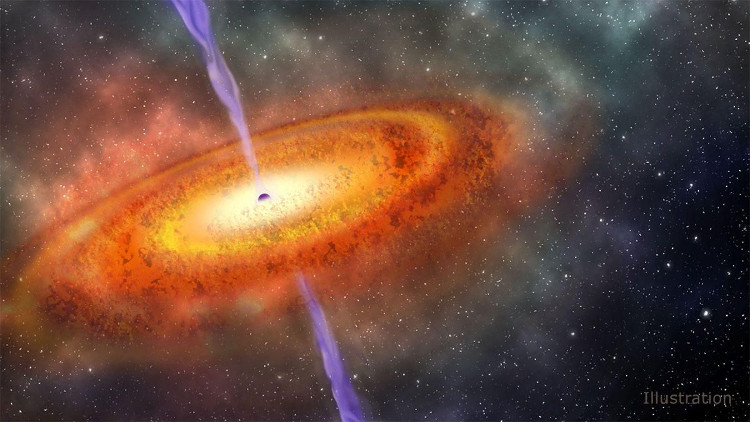Detecting huge black holes revealing the universe at the age of cradle
The discovery of a giant size, 13.1 billion light-years away from us, is revealing to scientists a lot.
Beasts, Goliath, relics, mysteries . are all the scientists are using to describe the most massive and far away black hole we have ever discovered in the universe.
A research team led by scientists from MIT, Carnegie Science Institute, NASA and Max Planck Institute of Astronomy recently published a new discovery in the journal Nature.

The giant black hole has just been discovered by us by 13.1 billion light-years.
located in the center of a quasar and raised by gas.
The researchers estimate that this black hole has 800 million times the mass of the Sun and it takes 13.1 billion years for its light to reach us. If supposedly 13.8 billion years ago, astronomers are seeing this black hole when the universe is only about 690 million years old. In terms of cosmology, the universe is just like a new school kid.
form the center of giant galaxies. They are thought to be one of the most luminous objects in the universe. The black holes inside them do not actually emit any light but the surrounding gas and dust move very fast and create a lot of friction that makes them produce a heat stream. However, these objects are basically impossible to see because of the distant quintessence from the earth.
Astronomers have used infrared light from dedicated telescopes to search for quasars. By doing this research, scientists can show where they are in the universe. Since the universe has expanded, quasars are increasingly distant, so that their light can expand into longer wavelengths and become redder. That is the basis for which we can know which quasar is farther away.
Currently, it is estimated that there are between 20 and 100 quasars at a distance of millions to billions of light years away from us.
In fact, astronomers believe that the newly discovered quasar is reproducing images of the universe during an important transition period. In the hundreds of millions of years after the Big Bang, the universe was a rather boring, long-time place known as the Dark Ages . There are no stars or black holes but instead are just dark matter with hydrogen and helium. In the end, these basic elements collapsed and merged into the first stars. These stars will create a wave of radiation, depriving electrons from the hydrogen around the universe. This is an important moment known as Epoch Reionization , in which hydrogen has shifted from neutral to ionizing and ended the Dark Ages period.

The figure depicts the development of quasars with the surrounding neutral hydrogen.(Photo of Carnegie Science Institute).
However, scientists cannot be sure about the exact time of the process. They think that the Dark Ages period takes place when the universe begins about 500 million years after the Big Bang and ends when it is 1 billion years old. And now, this quasar is giving them some answers. By studying light from this object, astronomers found that many of the hydrogen around this quasar is still neutral. Therefore, they believe that this quasar exists in the midst of Reionization.
- Three huge black holes are about to collide in the universe
- Detecting huge hollow black holes in the universe
- Discover the mystery of the most exotic black holes in the universe
- Decoding mistakenly thought that the black hole of the universe is
- The first black holes were
- New hypothesis: Black holes in the universe turn into
- Huge black hole swallowed the stars
- Why doesn't the black hole swallow the whole universe? This may be the answer!
- Why can black holes glow?
- Unexpectedly discovered 5 mysterious black holes in the universe
- Detecting two merging black holes in the universe
- Millions of black holes are hiding in our galaxy
 Van Allen's belt and evidence that the Apollo 11 mission to the Moon was myth
Van Allen's belt and evidence that the Apollo 11 mission to the Moon was myth The levels of civilization in the universe (Kardashev scale)
The levels of civilization in the universe (Kardashev scale) Today Mars, the sun and the Earth are aligned
Today Mars, the sun and the Earth are aligned The Amazon owner announced a secret plan to build a space base for thousands of people
The Amazon owner announced a secret plan to build a space base for thousands of people